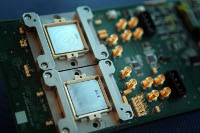1 Tbps 'Hybrid Memory Cube' Coming to Future Servers, Ultrabooks

Intel reported that its Hybrid Memory Cube is the fastest DRAM device to date. |
Intel has demonstrated its concept Hybrid Memory Cube, which is seven times more energy efficient than current DDR3 memory and has the highest data rates ever available in a single Dynamic Random Access Memory (DRAM) device.
The Hybrid Memory Cube was developed as part of a joint research project between Micron Technology and Intel. Intel claimed this new technology will enable cloud computing servers, as well as Ultrabooks, televisions, tablets, and smart phones, to scale dramatically while maintaining strict power and form factor budgets.
Increasing the cores on a microprocessor increases the need for memory. Available bandwidth to memory and its associated cost can impede performance scaling of servers and data centers. According to Intel, legacy DDR-style DRAM memory won't meet the needs of future high-end systems.
The Hybrid Memory Cube uses a stacked memory chip, which forms a compact cube, and uses a new, highly efficient memory interface that consumes less energy per bit transferred while supporting data rates of 1 trillion bits per second.
Key achievements of the Hybrid Memory Cube joint research project include:
- An input/output prototype with energy efficiency of 1.4 milliwatts per gigabit per second, optimized for the Hybrid Memory Cube;
- High-bandwidth memory architecture and protocol for the Hybrid Memory Cube; and
- Sustained data transfer rates (bandwidth) of 1 terabit per second (1 trillion bits per second).
Further information about the Hybrid Memory Cube is available at blogs.intel.com.
About the Author
Leila Meyer is a technology writer based in British Columbia. She can be reached at [email protected].